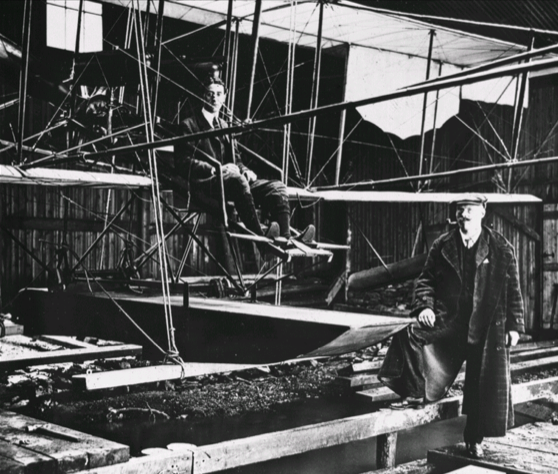
Hill of Oaks Site of the first 'seaplane' flight (1911) and first seaplane school (1911). Royal Naval Air Station 1916-1917
Hill of Oaks Caravan & Lodge Park
Lake Road,
Ulverston
Site of the hangar where Waterbird, the first British hydro-aeroplane to make a successfiul flight, was adapted for water trials and first flew 25th November 1911. The site was used as a pilot training facility for the RNAS during WW1.
In October 1909 Captain Edward Wakefield first saw flying machines in action at Blackpool Aviation week and declared his intention to have an aeroplave frly from water. He joined the Royal Aero Club in March 1910 and commisioned A.V Rose to build Waterbird, an Avro-Curtiss type aircraft design but adapted to take off and land on water. Contruction took place in Manchester with testing at Brooklands, delivered to Windermere in July 2911.
The first task at Windermere for Wakefield was to have a hangar designed and built. The site which he chose was land he owned at Hill of Oaks, on the south-east shore of the lake. He designed a new access road through Haws Wood and obtained planning permission on 24 January 1911. This photo is of the hangar prior to completion of the floor – Wakefield is standing.

Waterbird ‘had the distinction of being the first successful British hydro-aeroplane.’ – Flight magazine, 7 December 1912. More precisely, the first outside of France and the USA. The world’s first successful flight to use a stepped float, it was only achieved after considerable experimentation by Wakefield over 2 years and when a second step was added at the stern. The design of floats had become a science of its own. The floats were built by Borwick & Sons, boatbuilders of Bowness.
Photographs of Waterbird in flight and text occupied the entire front page of magazines: The Car (24 January 1912), The Aeroplane (25 January 1912), Flight (27 January 1912) and The Aero (February 1912), see photo gallery. Also, there was a feature in the French magazine Plein Air (16 February 1912).
The above Aeroplane magazine article included that, in spite of bad weather, Waterbird had by then made about 60 flights over 38 days, the furthest for 20 miles and up to 800 feet. and was regarded as being extremely successful.
The Red Wheel heritage plaque waas unveiled by Claire Hensman, Lord Lieutenant; Ian Gee, Waterbird and Jerry Swift, Deputy Chairman NTT
It was promtly reported in local press
A592 Newby Bridge-Windermere. Signposted on main road.
Hughes, Anne & Gee, Ian, Waterbird - Wings over Windermere, 2023, ISBN 987-1-3999-4904-0 2023